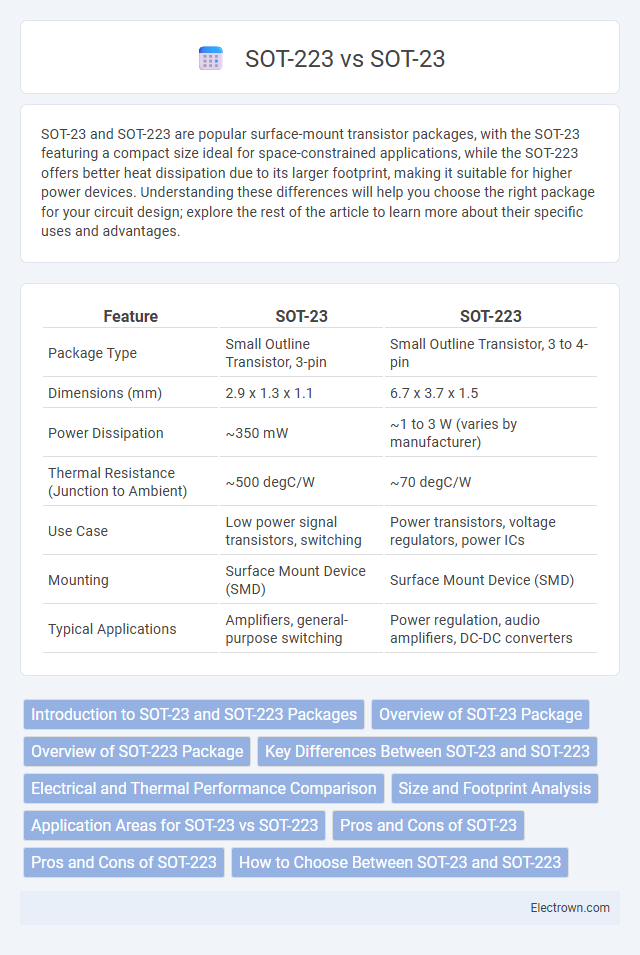SOT-23 and SOT-223 are popular surface-mount transistor packages, with the SOT-23 featuring a compact size ideal for space-constrained applications, while the SOT-223 offers better heat dissipation due to its larger footprint, making it suitable for higher power devices. Understanding these differences will help you choose the right package for your circuit design; explore the rest of the article to learn more about their specific uses and advantages.
Table of Comparison
| Feature | SOT-23 | SOT-223 |
|---|---|---|
| Package Type | Small Outline Transistor, 3-pin | Small Outline Transistor, 3 to 4-pin |
| Dimensions (mm) | 2.9 x 1.3 x 1.1 | 6.7 x 3.7 x 1.5 |
| Power Dissipation | ~350 mW | ~1 to 3 W (varies by manufacturer) |
| Thermal Resistance (Junction to Ambient) | ~500 degC/W | ~70 degC/W |
| Use Case | Low power signal transistors, switching | Power transistors, voltage regulators, power ICs |
| Mounting | Surface Mount Device (SMD) | Surface Mount Device (SMD) |
| Typical Applications | Amplifiers, general-purpose switching | Power regulation, audio amplifiers, DC-DC converters |
Introduction to SOT-23 and SOT-223 Packages
SOT-23 and SOT-223 are common semiconductor package types used in surface-mount technology, designed to house small electronic components such as transistors and diodes. SOT-23 packages are compact, typically featuring three leads, making them ideal for high-density circuit boards requiring space efficiency. SOT-223 packages are larger with four leads, offering better heat dissipation and higher power handling, which suits applications where thermal management is crucial for Your device's performance.
Overview of SOT-23 Package
The SOT-23 package is a small, three-lead surface-mount transistor outline commonly used in low-power semiconductor applications due to its compact size and lightweight design. It features a gull-wing lead configuration ideal for automated PCB assembly and provides efficient thermal performance for devices such as transistors, diodes, and small ICs. The SOT-23's minimal footprint, typically around 2.9mm x 1.3mm, makes it suitable for space-constrained electronic circuits compared to the larger SOT-223 package.
Overview of SOT-223 Package
The SOT-223 package is a small-outline transistor case commonly used for surface-mount devices, offering a larger footprint and improved heat dissipation compared to the SOT-23 package. It features a flat, rectangular body with three leads and an extended tab that enhances thermal performance, making it suitable for medium-power applications. This package supports semiconductors like voltage regulators and transistors that require better power handling without significantly increasing board space.
Key Differences Between SOT-23 and SOT-223
SOT-23 and SOT-223 differ primarily in size, power dissipation, and pin count, with SOT-23 being smaller and designed for low-power applications, usually featuring three pins. SOT-223 is larger, capable of handling higher power with better heat dissipation, and typically has four pins, making it suitable for power transistors and voltage regulators. Understanding these distinctions can help you choose the right package based on your circuit's thermal and electrical requirements.
Electrical and Thermal Performance Comparison
SOT-223 packages typically offer better thermal performance than SOT-23 due to their larger copper area and enhanced heat dissipation capabilities, making them suitable for higher power applications. Electrically, SOT-23 packages are preferred for low-power signals with minimal package parasitics, while SOT-223 supports higher currents and voltage ratings, reducing thermal resistance. The choice between SOT-23 and SOT-223 depends on the application's power requirements and thermal management needs, with SOT-223 enabling improved reliability in thermally demanding environments.
Size and Footprint Analysis
SOT-23 packages are significantly smaller, typically measuring around 2.9 mm by 1.3 mm, making them ideal for compact, space-constrained circuit boards. In contrast, SOT-223 packages are larger, approximately 6.7 mm by 3.7 mm, offering a bigger footprint which facilitates better heat dissipation for higher power components. Choosing between SOT-23 and SOT-223 depends on your design's space limitations and thermal management requirements.
Application Areas for SOT-23 vs SOT-223
SOT-23 packages are ideal for compact, low-power electronic circuits such as mobile devices, wearable technology, and small signal transistors due to their minimal footprint and efficient heat dissipation. SOT-223 packages excel in applications requiring higher power handling and thermal performance like voltage regulators, power transistors, and LED drivers, making them suitable for power management in consumer electronics and automotive systems. Selecting between SOT-23 and SOT-223 ensures your design meets specific power and size requirements in diverse electronic applications.
Pros and Cons of SOT-23
SOT-23 offers a compact footprint ideal for space-constrained applications, enabling lightweight, high-density PCB designs. Its reduced size can limit heat dissipation and power handling, which may challenge thermal management in high-power circuits. Compared to the larger SOT-223, SOT-23 is better suited for low-power, signal-level components but less effective for power transistors requiring efficient heat sinking.
Pros and Cons of SOT-223
SOT-223 offers a larger footprint and better heat dissipation than SOT-23, making it ideal for power transistors and voltage regulators in medium-power applications. The package size facilitates easier handling and improved thermal resistance but results in higher space consumption on PCBs compared to the more compact SOT-23. Despite these advantages, SOT-223 components may present limitations in high-frequency circuits due to increased parasitic inductance relative to SOT-23.
How to Choose Between SOT-23 and SOT-223
Choosing between SOT-23 and SOT-223 packages depends primarily on power dissipation requirements and size constraints. SOT-23 is ideal for low-power applications and compact designs due to its small footprint and limited thermal capacity. In contrast, SOT-223 supports higher power components with better heat dissipation, making it suitable for medium-power circuits where thermal management is critical.
SOT-23 vs SOT-223 Infographic

 electrown.com
electrown.com